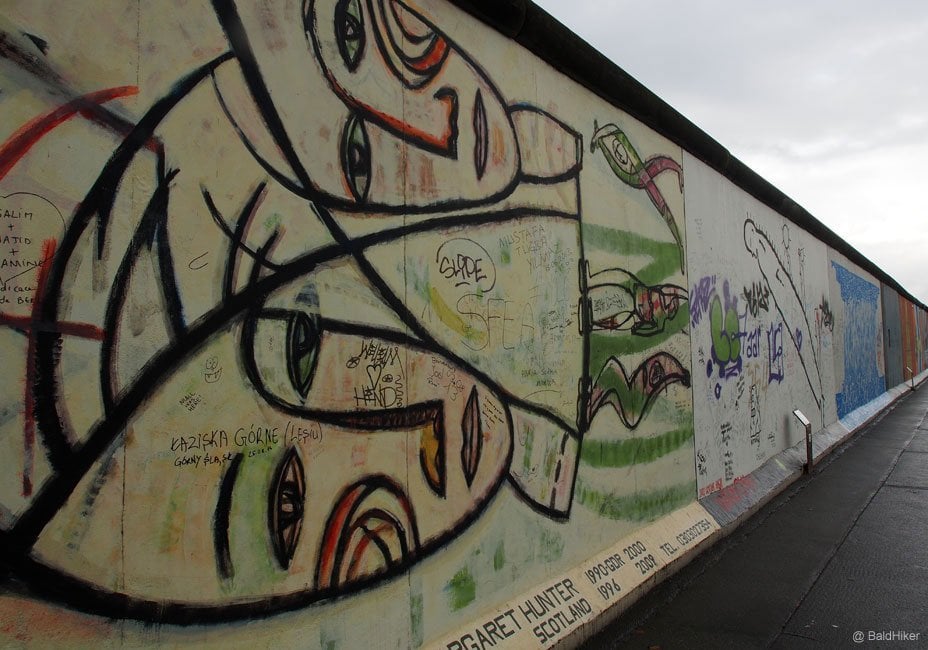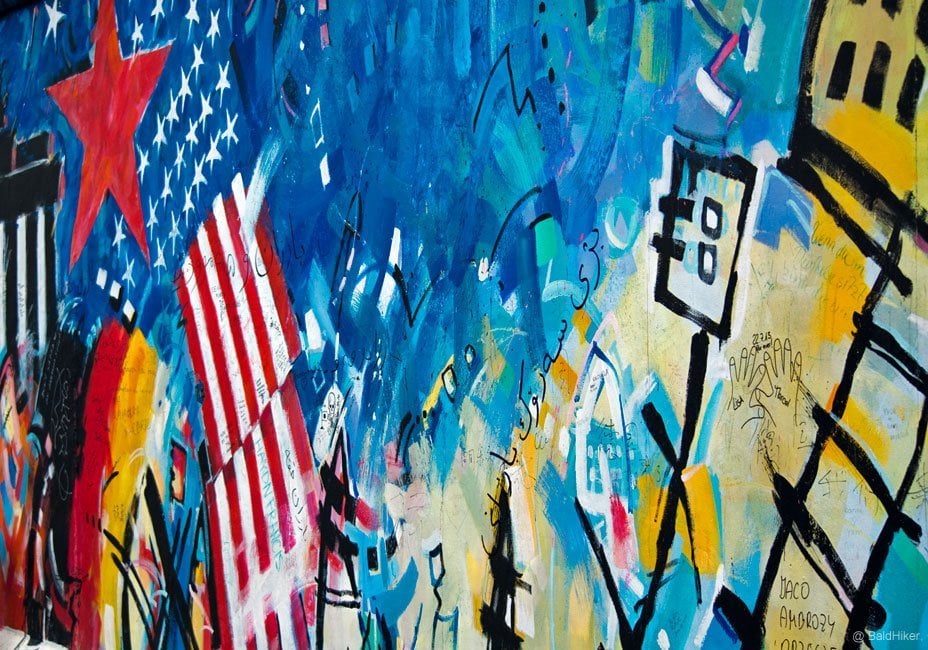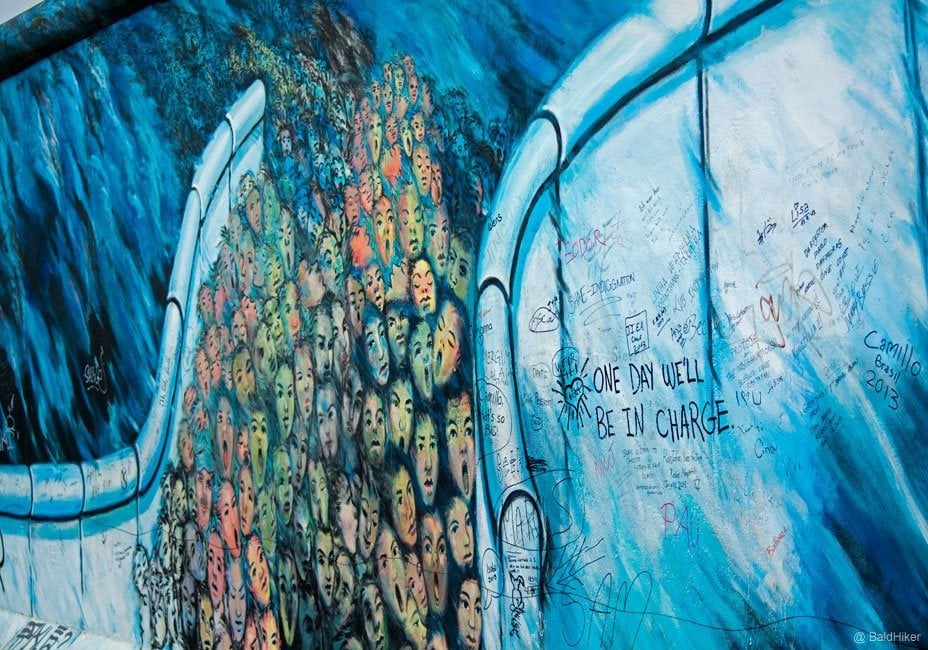Stretching for 1.3 kilometers along the River Spree, a concrete scar from a divided past has been transformed into the world’s longest open-air gallery.
This is the East Side Gallery, the longest remaining section of the Berlin Wall, a monument that no longer represents division, but rather a powerful and vibrant celebration of freedom, unity, and hope.
As you walk its length, you’re not just looking at art; you’re tracing the fault line of the Cold War, now covered in over 100 murals by artists from across the globe who gathered here in 1990 to paint their reactions to a world that had changed overnight.
This guide is designed to be your companion on that walk. We’ll cover everything from the practicalities of planning your visit to the powerful stories behind the most iconic paintings, ensuring you can fully appreciate this essential Berlin experience.

What is the East Side Gallery? A Quick Introduction
The East Side Gallery is a 1,316-meter-long section of the former Berlin Wall located in the Friedrichshain-Kreuzberg district.
Immediately after the wall fell in November 1989, this particular stretch was saved from demolition and, in 1990, 118 artists from 21 countries were invited to paint directly onto its eastern face—a side that had been a sterile, untouchable “death strip” for decades.
The result is an international memorial for freedom, a collection of artworks reflecting on the political turmoil of 1989/90 and expressing hope for a better future. It was granted protected memorial status in 1991 and remains one of Berlin’s most visited landmarks.

Planning Your Visit: The Essential Visitor’s Guide
A little planning goes a long way in making your visit to this historic site as smooth and meaningful as possible. Here are the key details you need to know.
How to Get to the East Side Gallery
The gallery’s length means it’s easily accessible from two main transport hubs that bookend the monument:
- Ostbahnhof Station: Located at the southern end. This is a major railway station served by S-Bahn and regional trains.
- Warschauer Straße Station: At the northern end, near the famous Oberbaumbrücke. This station is a hub for S-Bahn and U-Bahn lines (U1, U3).

Both stations are perfect starting points for walking the gallery from one end to the other. For a more scenic approach, you can take the U-Bahn to Schlesisches Tor and enjoy a walk across the iconic Oberbaumbrücke before you begin.
Opening Hours and Best Times to Visit
As an open-air monument, the East Side Gallery is accessible 24 hours a day, 7 days a week, and is completely free to visit.
However, the entire 1.3 km walk is completely exposed to the elements, so it’s wise to check the weather forecast before you go.

For the best experience with fewer crowds and better light for photography, I recommend visiting on a weekday in the early morning or late afternoon.
Guided Tours vs. Self-Guided Walks
There are several ways to experience the gallery, depending on your preference:
- Self-Guided Walk: The most popular option is to simply walk the gallery at your own pace. This gives you the freedom to spend as much time as you like at the murals that resonate with you most.
- Public Guided Tours: The Berlin Wall Foundation offers regular public tours that last about an hour and are conducted with audio guides. These are free for schoolchildren, and registration is not typically required.
- Private Guided Tours: For a more in-depth experience, you can book a private tour for your group, often with a specific thematic focus.

Route of the East Side Gallery and Key Murals
The gallery follows a simple, linear path along Mühlenstraße, situated between the River Spree on one side and the road on the other.
The two main anchor points are the Ostbahnhof station to the south and the Oberbaumbrücke bridge (near Warschauer Straße station) to the north.
The most famous murals are spread out along the entire length, so a full walk is recommended to see them all.

Pro Tips for Your Walk
- Wear Comfortable Shoes: This is a 1.3 km walk, so comfort is key.
- Start at One End: Pick either Ostbahnhof or Warschauer Straße and walk the full length to ensure you don’t miss anything.
- Explore Kreuzberg: After your walk, cross the Oberbaumbrücke into the Kreuzberg district. It’s a vibrant, artsy area known for its fantastic street food, independent shops, and laid-back vibe.
- Passport Stamps: Be aware of souvenir stalls offering to stamp your passport with replica Cold War-era border crossing stamps. Using these can potentially invalidate your official travel document.

A Curated Walk Along the Wall: The 10 Most Famous Murals and Their Stories
As I walked along the gallery, certain images stood out not just for their artistic merit, but for the powerful stories they tell. Here are ten of the most unmissable murals and the history behind them.

1. Dmitri Vrubel – “My God, Help Me to Survive This Deadly Love” (The Fraternal Kiss)
Undoubtedly the most photographed mural in the gallery, this piece by Russian artist Dmitri Vrubel is an icon of post-Cold War Berlin.
It depicts the “socialist fraternal kiss” between Soviet leader Leonid Brezhnev and East German President Erich Honecker, based on a 1979 photograph.
Vrubel, who found the original image “repulsive,” added the caption, “My God, help me to survive this deadly love.” The painting became a searingly ironic symbol of the failing communist system.
2. Birgit Kinder – “Test the Rest” (The Trabant)
This clever and hopeful mural shows a Trabant—the notoriously flimsy, plastic-bodied car that was a symbol of East Germany—appearing to burst right through the concrete wall.
Artist Birgit Kinder explained that the car is unscratched to represent the peaceful nature of the revolution that brought down the wall, a triumph of the people over an oppressive regime without bloodshed.
3. Thierry Noir – “Hommage to the Young Generation”
The vibrant, cartoonish heads of Thierry Noir are synonymous with the Berlin Wall itself. As a young French artist living near the wall in the 1980s, he was one of the first to begin illegally painting it in 1984.
He developed his distinctive, simple style so he could paint quickly and evade the guards.

He considers his work on the East Side Gallery not a piece of dangerous protest art, but an “homage to the young generation” to remember that the wall was never an art project, but a deadly border.
4. Gabriel Heimler – “The Wall Jumper”
At first glance, this mural seems to depict an escape from East to West. But artist Gabriel Heimler intended the opposite: it’s a West German jumping over to the East, a symbolic act of freedom and a gesture towards reunification.
Heimler wanted to capture the euphoric “moment of dream” that followed the wall’s fall, an expression of hope for living together without enemies.

5. Kani Alavi – “It Happened in November”
Iranian-born artist Kani Alavi was a key organizer of the East Side Gallery project.
His mural was inspired by his own experience watching the wall fall from his apartment window near Checkpoint Charlie. He recalled seeing not just joy, but also “sad, insecure and frightened faces” in the crowd.

His painting captures this complex swirl of emotions, showing a torrent of faces flowing through the breach in the wall.
6. Mikhail Serebrajakow – “Diagonal Solution to Problems”
This thought-provoking piece is a powerful critique of authoritarianism. It shows a person’s thumb being forcibly held up in a “thumbs up” gesture by a chain.
The message is clear: it illustrates how citizens in the Soviet bloc were often compelled to feign positivity and agreement out of fear, as voicing any opposition was incredibly dangerous.
7. Günther Schaefer – “The Homeland”
Günther Schaefer’s mural uniquely combines the German flag and the Israeli Star of David. He painted it to commemorate the 50th anniversary of Kristallnacht (The Night of Broken Glass), the Nazi pogrom against Jews that took place on November 9, 1938.
By linking the two flags, Schaefer created a powerful statement against extreme political regimes and human rights abuses.

8. Margaret Hunter & Peter Russell – “Hands”
While many murals have been repainted, this one is special. “Hands” is the only painting that remains in its original 1990 state.
It was not touched during the major restorations of 2000 and 2009, making it an authentic time capsule.
Seeing its weathered surface gives you a real sense of how the original artworks looked and the impact of time and the elements on this outdoor gallery.

9. Christine Kühn – “Touch the Wall”
The story behind this piece captures the spirit of 1990. Artist Christine Kühn invited passers-by to dip their hands in paint and press them onto her section of the wall.
This simple act was deeply symbolic, transforming a barrier that was once lethal to touch into a collaborative work of art. Tragically, during the 2009 restoration, the original handprints were painted over, and Kühn had to use her own, altering the original community-focused meaning.
10. Jim Avignon – “Doin it Cool for the Eastside”
This mural is a flashpoint for the debate over preservation versus evolution. Jim Avignon’s original 1990 painting depicted East Berliners shocked by Western consumerism.
By 2013, he felt the piece was dated. Instead of repainting the original, he illegally painted a completely new mural over it, reflecting modern Berlin’s struggles with gentrification and identity.
His act sparked a major controversy about whether the gallery should be a static memorial or a living canvas.
The Story of the Gallery: From Death Strip to World’s Longest Open-Air Gallery
The existence of the East Side Gallery is a direct consequence of one of the 20th century’s most dramatic events. Understanding its history deepens the experience of walking its length.
The Fall of the Wall: The Canvas is Created (November 1989)
When the Berlin Wall was breached on the night of November 9, 1989, decades of division ended almost instantly.
In the months that followed, most of the wall was torn down. The idea to preserve a section as a monument and art gallery came from a group of artists, who successfully lobbied for this 1.3 km stretch on Mühlenstrasse to be saved.
118 Artists, 21 Countries: The Painting of the Gallery (1990)
In the spring of 1990, the project officially began. Coordinated by Christine McLean, 118 artists from 21 nations were invited to participate.
They were given no artistic restrictions, only the simple instruction to “paint what they felt”. For the first time in history, the eastern side of the wall was covered in art, and on September 28, 1990, the East Side Gallery officially opened.
Decay and Controversy: The 2009 Restoration
Being an outdoor gallery, the murals were immediately exposed to weather, pollution, and vandalism. By the late 2000s, many were badly deteriorated.
For the 20th anniversary of the wall’s fall in 2009, a major restoration project was undertaken. The original artists were invited back to repaint their works.
This sparked a heated debate: many felt that repainting a 20-year-old piece would create an inauthentic copy, devoid of the raw emotion of 1990. Some refused to participate, while others, like Jim Avignon, took matters into their own hands.

The East Side Gallery Today: Preservation and What to See Nearby
The gallery’s story is not over. It continues to be a site of active preservation and is surrounded by a dynamic, modern Berlin.
Protecting the Monument: The Berlin Wall Foundation
For years, the gallery faced threats from commercial building projects, which led to public protests to save the monument.
In a victory for preservationists, the East Side Gallery was transferred to the care of the official Stiftung Berliner Mauer (Berlin Wall Foundation) in 2018. This organization is now responsible for its long-term protection and upkeep.

Beyond the Wall: Exploring Friedrichshain and Kreuzberg
The gallery is perfectly positioned between two of Berlin’s most interesting neighborhoods.
- Friedrichshain: The side of the gallery itself, this area is home to the Uber Arena, a major venue for concerts and sports.
- Kreuzberg: Just across the beautiful Oberbaumbrücke bridge, you’ll find Kreuzberg. This district is famous for its multicultural community, thriving arts scene, and some of the best street food in the city.
The gallery is also a great starting point for exploring more of Berlin’s complex history. A short S-Bahn ride will take you to the iconic Reichstag Building, with its glass dome offering views over the city









Thanks for sharing Cindy! really great picts
Art and emotions. a piece of all us in that wall…. beatuful pics, thanks for sharing
Beautiful pictures! I love that they are able to turn the wall into a celebration.
Really fascinating! a way to highlight a part of our history that is still there on that wall.
Thank you Mark for your kind comment!
A fascinating look at Berlin. Unfortunately the graffiti has the effect for some people of removing some of what the wall stood for.
Thanks James, I know what you mean. But if it hadn’t been turned into a gallery it probably would have totally disappeared in time….